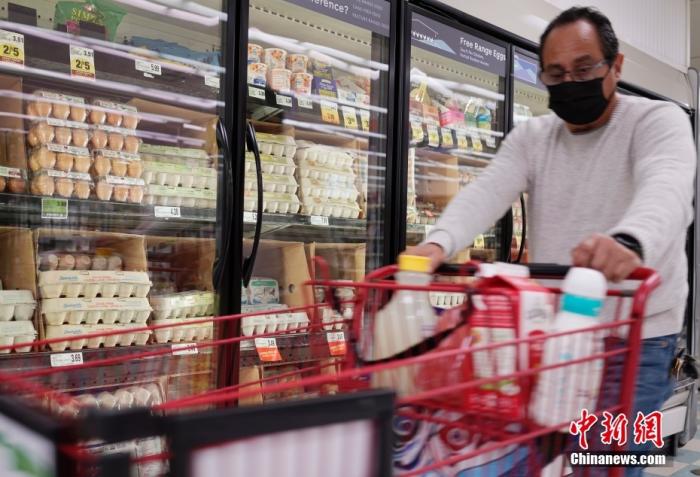China News Service, Beijing, April 30 (Zhang Mingxin) The latest data released by the US Department of Commerce on the 28th local time showed that the US gross domestic product (GDP) in the first quarter of 2022 fell by 1.4% at an annual rate.
This data completely took off the "gorgeous coat" of the US economy.
Although U.S. President Biden is optimistic that he is "not worried", the "wake-up call" has already sounded - as the epidemic continues to spread, the trade deficit continues to widen, and inflation continues to rise, the risk of a U.S. economic recession is rising, and there will be more in the future. There will be more challenges.
On April 5, local time, a customer passed by an egg container in a supermarket in San Mateo County, California.
Photo by China News Agency reporter Liu Guanguan
Multiple factor superposition
U.S. GDP slumps in first quarter
According to a CNN report, the U.S. Commerce Department released a report on the 28th local time that the U.S. economy will shrink by 1.4% in early 2022, a dramatic drop from a 6.9% increase in the fourth quarter of 2021, lower than analysts’ forecast. 1.1% growth.
This is also the worst performance of U.S. GDP since the outbreak of the new crown epidemic in the United States in 2020.
In 2021, US GDP will increase by 5.7% year-on-year, the highest value since 1984.
The Commerce Department cited a widening trade deficit, weak inventory investment, and reduced government spending as the main reasons for the decline in GDP.
The British "Financial Times" analysis, the rising trade deficit has pulled down the US GDP figures.
The U.S. trade deficit hit a record high in March as import volumes and prices surged.
The combination of strong import demand and changes in the trade deficit undermined GDP growth of 3.2%.
In terms of inventory investment, the Associated Press pointed out that since 2020, in the context of the continued spread of the global epidemic, the instability of the supply chain has led to inventory shortages, which has led to an increase in the willingness of American companies to replenish inventory.
In the first quarter of 2022, the willingness of U.S. companies to replenish inventories has declined, reducing GDP by 0.8%.
In terms of government spending, lower defense spending, expiry of government programs, and child tax credits all contributed to the decline in government spending, dragging down GDP growth.
Biden: Don't worry
Economist: Shocking
U.S. GDP has fallen sharply, but U.S. President Biden is optimistic.
According to Fox Business News, on the 28th local time, Biden publicly stated that he is not worried about a recession in the U.S. economy.
Data map: US President Biden.
In the first quarter of 2022, U.S. consumer spending, business investment and residential investment continued to grow at strong rates, Biden said in his statement.
He also said the number of Americans receiving unemployment insurance benefits in the first quarter was at its lowest level since 1970.
However, Kenneth Rogoff, a Harvard professor and former chief economist at the International Monetary Fund, expressed concern about the U.S. economic outlook, according to Fox Business News.
He said the U.S. economic contraction in the first quarter was "shocking."
Rogoff said the 1.4 percent drop in GDP was "worse than even his worst-case scenario."
He also said that negative GDP growth and rising inflation are not good for the macroeconomic situation.
Chris Zaccarelli, chief investment officer at the Alliance of Independent Advisors, said the numbers were "a wake-up call" that the economy wasn't as strong as people thought.
In addition, Rick Santelli, editor of Consumer News and Business Channel (CNBC), also said that the 1.4% decline in GDP was "nasty."
Risk is coming
U.S. media worry about rising possibility of recession
Although some economists believe that the US economy will not fall into a full-blown recession.
But in response to the rapid rise in inflation, the Fed plans to implement a series of tightening monetary policy, including faster pace of raising interest rates, which is bound to drag on economic growth.
At present, the risks are rising, and the Associated Press reported that the US economy is currently in an unusual and challenging situation.
On March 6, local time, a car owner refueled his vehicle in San Mateo County, California.
Photo by China News Agency reporter Liu Guanguan
One of the challenges facing the U.S. economy is the impact on consumers.
The Associated Press pointed out that some Republican lawmakers and economists believe that the decline in GDP shows the risks posed by soaring inflation.
Despite the increase in net worth, consumers will "become timid."
In addition, the more serious challenge facing the US economy is recession.
CNN expressed concern about the outlook for the U.S. economy, "although the first-quarter GDP is not a reason for today's economic panic, the risks are looming, and the possibility of a recession in 2023 or 2024 has risen."
The Fox Business News report also mentioned that Rogoff said that in 2023, the probability of the United States experiencing a recession is at least 50%.
He said that if the Fed does not raise interest rates significantly, there will be inflation, but if they do, it will create a massive recession.
CNBC reported that Deutsche Bank believes that the U.S. economy may experience a "severe recession" in late 2023 and early 2024.
The agency said it would be the result of the Federal Reserve tightening monetary policy to curb inflation, and the situation was far more dire than widely expected.

